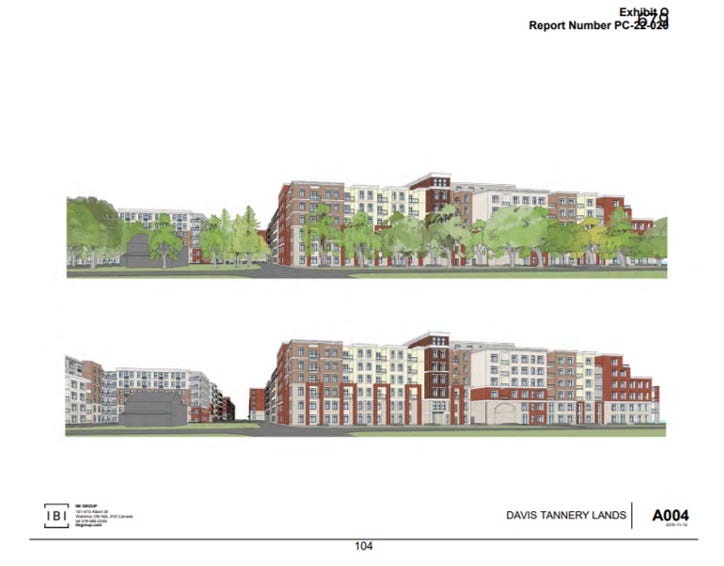UNESCO = United Nations Educational, Scientific and Cultural Organization
The Rideau Canal was inscribed as a UNESCO World Heritage Site in 2007.
# 7 – The subject site is adjacent to the Rideau Canal UNESCO World Heritage Site, National Historic Site of Canada and Canadian Heritage River.
# 8 – The heritage value and character-defining elements of the Rideau Canal National Historic Site of Canada are set out in the Commemorative Integrity Statement approved September 2000, and on the Canadian Register of Historic Places found on www.historicplaces.ca
# 9 – Other than the Rideau Canal, there are no other designated heritage resources immediately “adjacent” to the subject site as defined under the PPS or the Official Plan. However, there are other cultural heritage resources designated under the Ontario Heritage Act in proximity to the subject site, including the Woolen Mill, that bear consideration in this hearing.
The impact of the development on the Rideau Canal
“All expert witnesses at the hearing were in agreement that consideration of the impact on the Rideau Canal is required.” (Appellant, para. 134)
The Appellant argues “the mid-rise building height will conserve the prominence of Belle Island as a significant landform” and the development is setback from the Rideau Canal with a 30 to 50 metre ‘ribbon of life’” which is a greater setback “than that of the Woolen Mill.” (para 138)
The City’s written submission starts by stressing that one of the “primary issues for this hearing is that the proposed development does not conserve the heritage values of the Rideau Canal World Heritage Site” which is “of critical importance to the City.” (para. 3)
Landscaping, Trees, the 30 m Buffer
Can the impact of the four proposed buildings on the protected Rideau Canal be minimized by tree plantings, a buffer zone along the water, and landscaping?
“The … uncontested evidence was that remediation would require the removal of the majority of the Property’s tree cover” (Appellant, para. 234) which is “dominated by invasive species. (Reply, para. 59)
“The Landscape Strategy details the proposed naturalized shoreline, with new plantings that will provide the necessary vegetative screening from the Rideau Canal.” (Appellant, para. 139)
In the opinion of one of the Appellant’s expert witnesses, “there is no requirement to fully screen the height of the buildings to promote or conserve heritage value of the Rideau Canal. The requirement suggested by [the City’s witness] to have trees tall enough to cover the Proposed Development is not contained in the PPS, OP or any cultural heritage documents.” (para. 144)
The Appellant’s witness’ evidence was that “tree plantings and landscaping along public streets will reinforce the character of the neighbourhood, and plantings will aid in transitioning the Property to the PSW to the immediate north and Belle Park and Belle Island beyond [conserving] the cultural heritage value and attributes of the Rideau Canal.” (para. 139)
The City argues that the landscaping does not mitigate the buildings’ effect noting that “proposed buildings are not low-profile and they will significantly exceed the height of the tree canopy, contrary to Principle 7 of the Rideau Canal Waterway Principles for Good Waterfront Development.” (City, para. 74)
“[R]esidents and visitors will be exposed to the out-of-scale, out-of-character buildings for several decades while the trees mature (assuming revegetation is possible given the uncertainties with remediation). After decades, when the foliage is mature, the buildings will not be any less out-of-scale or out-of-character. Further, every fall through to the next spring everyone will be reminded once again how incompatible the buildings are when the trees lose their leaves.” (para. 83)
The City notes that screening of the north sides of the buildings was not assessed by the Appellant and is a “critical failure.” (para. 86)
Image from one of the Appellant’s planning documents presented to the City in 2022.
30 metre buffer along the water – the riparian corridor
The Appellant states that there will be “no negative impact to the riparian corridor as the shoreline of the Property will be revegetated after remediation. There is a range of vegetated outcomes that can achieve a necessary riparian function for this area.” (Appellant, para. 293)
No Clearcuts Kingston disagrees with the Appellant’s interpretation of “negative impacts” (para. 28) and points out that “[d]espite the … ecological benefits of woodlands, the Appellant is proposing to wholly remove (and not fully replace) all trees, brush, and vegetation that currently exist on the upland portion of the subject property, including the 30-60 m riparian buffer… a net loss of approximately 5.5 ha of on-site woodland if the proposed development is approved.” (No Clearcuts Kingston, para. 35)
Not only will trees and other vegetation be lost, but it is also not clear how much new planting can be done.
The Appellant “presented a conceptual landscaping plan that is devoid of implementation details but proposes selective tree plantings at unknown locations to unspecified depths (despite the cap presence) within the 30-60 m ‘ribbon of life’ zone along the river shoreline. [The appellant’s witness] acknowledged that planting a small handful of trees in this narrow strip of land will not fully recreate the nature and extent of the wildlife habitat currently provided by that on-site woodland. (para. 36)
The City argues that the minimum 30 m buffer in the UNESCO inscription “includes a portion of the PSW on site and the PSW in its entirety is part of the character-defining elements of the Rideau Canal heritage landscape that is protected.” (para. 57)
“In order to mitigate the otherwise incompatible buildings this Tribunal must accept that mitigation is possible. Every witness agreed that the MECP [Minister of the Environment, Conservation and Parks] retains approval authority over the final remediation plan and what, if any, landscaping can be planted after remediation.” (para. 87)
The Appellant counters that “[a]llegations that trees cannot be planted are inconsistent with the evidence.” (Reply, para. 79)
Tannery Land arguments review
A series of posts outlining key arguments made in the parties’ written submissions.
# 1 Tribunal decision on Tannery Lands soon? The wetland issues






Kingston still has the Courthouse. May we also have The Tannery.